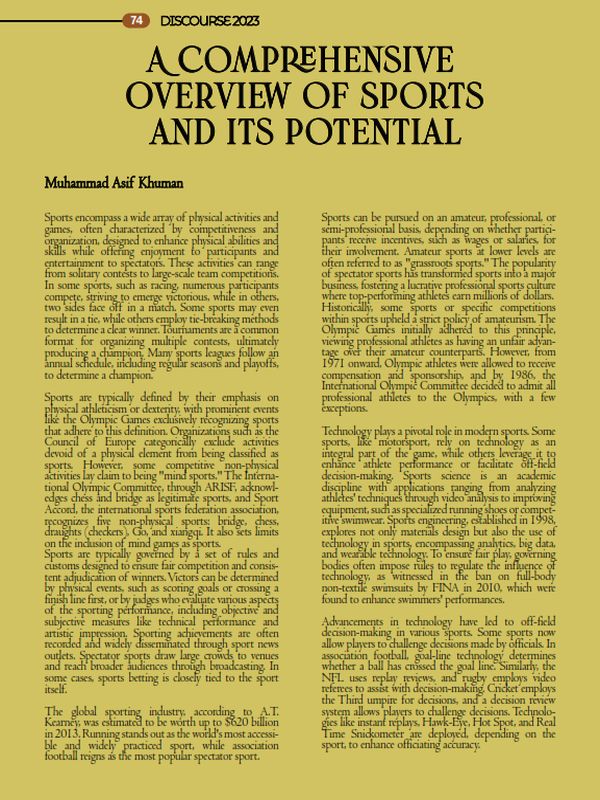
Pakistan Institute of Development Economics
- Home
Our Portals
MenuMenuMenuMenuMenuMenuMenu - ResearchMenuMenuMenuMenuMenuMenuMenu
- Discourse
- The PDR
- Our Researchers
- Academics
- Degree Verification
- Thesis Portal
- Our Portals
A Comprehensive Overview of Sports and its Potential
Sports encompass a wide array of physical activities and games, often characterized by competitiveness and organization, designed to enhance physical abilities and skills while offering enjoyment to participants and entertainment to spectators. These activities can range from solitary contests to large-scale team competitions. In some sports, such as racing, numerous participants compete, striving to emerge victorious, while in others, two sides face off in a match. Some sports may even result in a tie, while others employ tie-breaking methods to determine a clear winner. Tournaments are a common format for organizing multiple contests, ultimately producing a champion. Many sports leagues follow an annual schedule, including regular seasons and playoffs, to determine a champion.
Sports are typically defined by their emphasis on physical athleticism or dexterity, with prominent events like the Olympic Games exclusively recognizing sports that adhere to this definition. Organizations such as the Council of Europe categorically exclude activities devoid of a physical element from being classified as sports. However, some competitive non-physical activities lay claim to being “mind sports.” The International Olympic Committee, through ARISF, acknowledges chess and bridge as legitimate sports, and Sport Accord, the international sports federation association, recognizes five non-physical sports: bridge, chess, draughts (checkers), Go, and xiangqi. It also sets limits on the inclusion of mind games as sports.
Sports are typically governed by a set of rules and customs designed to ensure fair competition and consistent adjudication of winners. Victors can be determined by physical events, such as scoring goals or crossing a finish line first, or by judges who evaluate various aspects of the sporting performance, including objective and subjective measures like technical performance and artistic impression. Sporting achievements are often recorded and widely disseminated through sport news outlets. Spectator sports draw large crowds to venues and reach broader audiences through broadcasting. In some cases, sports betting is closely tied to the sport itself.
The global sporting industry, according to A.T. Kearney, was estimated to be worth up to $620 billion in 2013. Running stands out as the world’s most accessible and widely practiced sport, while association football reigns as the most popular spectator sport. Sports can be pursued on an amateur, professional, or semi-professional basis, depending on whether participants receive incentives, such as wages or salaries, for their involvement. Amateur sports at lower levels are often referred to as “grassroots sports.” The popularity of spectator sports has transformed sports into a major business, fostering a lucrative professional sports culture where top-performing athletes earn millions of dollars.
Historically, some sports or specific competitions within sports upheld a strict policy of amateurism. The Olympic Games initially adhered to this principle, viewing professional athletes as having an unfair advantage over their amateur counterparts. However, from 1971 onward, Olympic athletes were allowed to receive compensation and sponsorship, and by 1986, the International Olympic Committee decided to admit all professional athletes to the Olympics, with a few exceptions.
Technology plays a pivotal role in modern sports. Some sports, like motorsport, rely on technology as an integral part of the game, while others leverage it to enhance athlete performance or facilitate off-field decision-making. Sports science is an academic discipline with applications ranging from analyzing athletes’ techniques through video analysis to improving equipment, such as specialized running shoes or competitive swimwear. Sports engineering, established in 1998, explores not only materials design but also the use of technology in sports, encompassing analytics, big data, and wearable technology. To ensure fair play, governing bodies often impose rules to regulate the influence of technology, as witnessed in the ban on full-body non-textile swimsuits by FINA in 2010, which were found to enhance swimmers’ performances.
Advancements in technology have led to off-field decision-making in various sports. Some sports now allow players to challenge decisions made by officials. In association football, goal-line technology determines whether a ball has crossed the goal line. Similarly, the NFL uses replay reviews, and rugby employs video referees to assist with decision-making. Cricket employs the Third umpire for decisions, and a decision review system allows players to challenge decisions. Technologies like instant replays, Hawk-Eye, Hot Spot, and Real Time Snickometer are deployed, depending on the sport, to enhance officiating accuracy.
Research indicates that sports have the potential to connect youth with positive adult role models, provide opportunities for positive development, and promote the acquisition of life skills. In recent years, sports have been utilized to combat crime and prevent violent extremism and radicalization. Sports programs aim to boost self-esteem, strengthen social bonds, and provide participants with a sense of purpose.
While the potential benefits of sports participation are recognized, high-quality evidence supporting interventions to increase community sports participation or promote healthy behavior change remains limited. Strategies such as mass media campaigns, educational sessions, and policy changes require further investigation to assess their effectiveness.
Sports are a diverse and dynamic aspect of human culture, encompassing a broad spectrum of physical activities that resonate with participants and spectators alike. With evolving rules, technology, and societal influences, the world of sports continues to evolve, offering both challenges and opportunities for athletes, organizations, and communities. Further research and evidence-based approaches are essential to harness the full potential of sports in promoting physical activity, social integration, and personal development.
Taking the world of sports seriously is indispensable for people occupying policy spaces in Pakistan, a country that constitutes a major youth bulge. For this to be possible, however, key ministries and government agencies must be populated with individuals that have expertise in both the technical and managerial aspects of various sporting domains. There is little to lose – everything to gain. And the time is now.
The author is an English Instructor at The Hunar Foundation.



